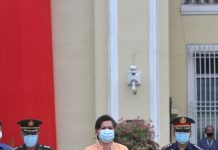The Mines and Geosciences Bureau (MGB) is concerned about possible delay in its ongoing mapping of geohazards in selected populated areas nationwide as the agency reported experiencing at present shortage of personnel to undertake this work.
“We’re already running out of manpower,” said Dr. Karlo Queaño, section chief of MGB’s Geological Database and Information System which is involved in the five-year project that commenced in 2011.
Several of MGB’s technical personnel already either resigned to work elsewhere or retired already so the agency is in dire need of manpower, he said.
He acknowledged government’s implementing a freeze hiring policy at present but hopes MGB can be allowed to hire additional personnel as soon as possible, particularly since the agency has extra work to do aside from its original task of assessing geohazard risks in the target areas.
Such extra work involves producing base maps each at a scale of 1:10,000 meters so more of the target areas’ existing features like roads and infrastructure can be shown, he said.
“This must be done because the National Mapping and Resource Information Authority (NAMRIA) hasn’t enough base maps at that scale,” he said.
NAMRIA is the government agency that surveys and maps the country’s land and water resources.
Queaño noted that base maps are essential in eventually producing at the same 1:10,000 meters scale digitized geohazard maps which show more information on landslide and flooding risks in the target areas.
Such information includes flooding level and the type of landslide likely to occur in a target area, he said.
Geohazard maps at the smaller scale of 1:50,000 meters can only show an area’s susceptibility to landslide and flooding, he clarified.
“Maps at 1:10,000 meters are more useful in terms of land use and management,” he said.
Malacañang wants the geohazard maps distributed to local authorities nationwide so they can better plan and implement disaster risk reduction measures for their respective areas of jurisdiction.
Queaño said MGB’s central office is supposed to produce annually geohazard maps for 40 target municipalities.
Each of MGB’s regional offices must produce maps for 20 municipalities, he added.
He reported MGB was able to complete so far four maps only due to personnel shortage.
If map production continues at such pace, he noted it’s doubtful if the project can be completed on time. [PNA]
To help address the situation temporarily, Queaño and colleagues proposed for the MGB central office deployment of two teams to undertake the work.
“One team will do the base maps while the other will assess the target areas,” Queaño said.
He noted the team that will do the base maps need not be composed of geologists.
“I hope we can hire more contractuals to do this work, however,” he said.
If the proposed two-team strategy helps, he hopes MGB’s regional offices can adapt this also so more digitized geohazard maps can be produced.






